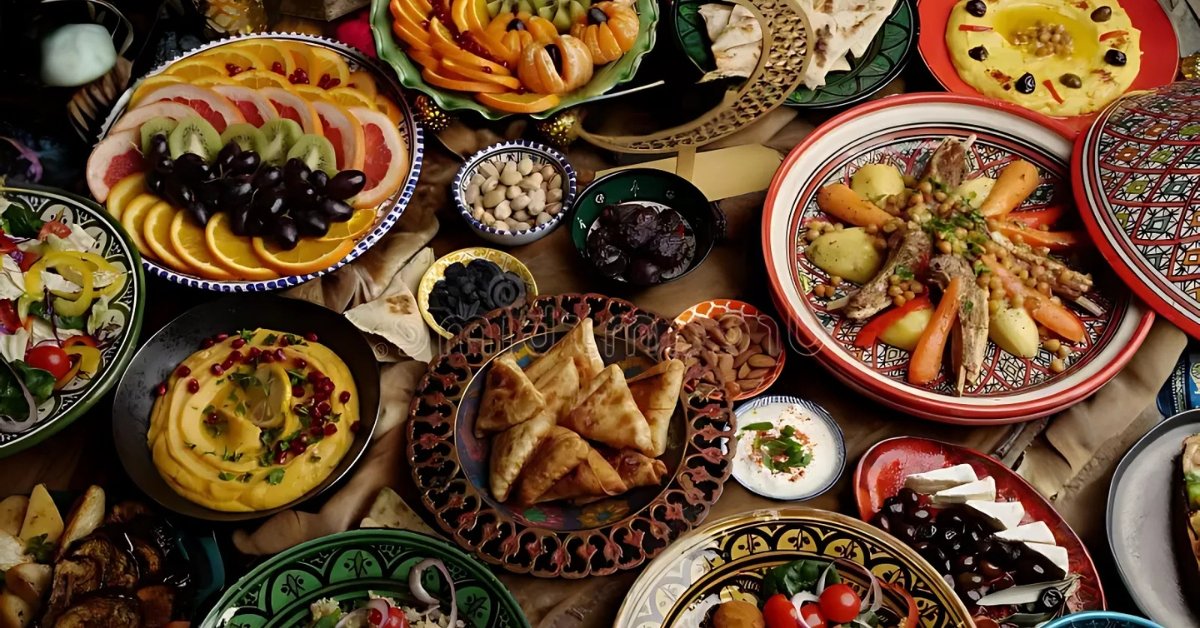Welcome, fellow food lovers! Get ready to embark on a delicious adventure because Moroccan Cuisine is truly a vibrant celebration of history, culture, and absolutely incredible flavor. Imagine a culinary landscape where the rich influences of Berber, Arab, Andalusian, and Mediterranean traditions all come together in a beautiful harmony. It’s a place where fragrant spices like warm cumin, golden saffron, and sweet cinnamon don’t just season the food – they dance with diverse, fresh ingredients like tender lamb, fluffy couscous, and those wonderfully briny Moroccan olives. And let’s not forget the cooking! From the slow, gentle embrace of the tagine pot to the truly unique method behind the Tanjia and the smoky allure of grilling over open flames, Moroccan cooking techniques create dishes that feel deeply rooted in tradition yet burst with vibrant, wonderful taste. This ultimate guide explores the heart of Moroccan cuisine, promising delicious discoveries for anyone interested in Moroccan food.
Think of this as your personal invitation to explore some of the most defining dishes that make Moroccan cuisine so special. We’re going to take a close look at 11 essential traditional Moroccan dishes and then hit the bustling streets to discover 10 must-try Moroccan street food delights that offer a quick, authentic taste of daily life. For each, we’ll peel back the layers on its background, detail the crucial ingredients, and give you clear steps to bring these genuine Moroccan tastes alive in your own kitchen. Get ready to move beyond the familiar and discover the deep, satisfying pleasures of Moroccan cooking and eating the Moroccan way.
More Than Just a Meal: The Profound Place of Food in Moroccan Life
It’s vital to grasp that in Morocco, Moroccan food transcends simple sustenance. Every shared meal is an act of connection, a potent expression of hospitality, and a living link to a vibrant cultural heritage. Many signature dishes of Moroccan cuisine are presented for everyone to gather around, encouraging shared moments and embodying the genuine warmth and generosity that defines the Moroccan spirit. The communal nature of Moroccan cooking is a key part of its charm.
Essential Dishes That Define Moroccan Cuisine: Your Kitchen Adventure Begins!
Let’s lift the lid on some of the most compelling dishes that form the very soul of Moroccan cooking. We’ve included approachable recipes to help you recreate the magic of traditional Moroccan cuisine at home. Each dish is a testament to the depth and diversity of Moroccan gastronomy.
1. Tagine: The Iconic Moroccan Slow Cook
The ubiquitous tagine, named after the distinctive conical clay pot in which it’s cooked, is a cornerstone of Moroccan cuisine. This slow-cooked stew masterfully balances savory and sweet, typically featuring meat (most often lamb or chicken) with a fragrant mix of Moroccan spices and dried fruits like apricots or prunes. The tagine pot’s design is crucial, allowing steam to condense and drip back down, infusing every single bite with rich, concentrated flavors. Beloved for everyday meals and centerpiece for feasts, the tagine is undeniably woven into the fabric of Moroccan culinary identity. It is arguably the most recognizable dish of Moroccan cuisine and essential to understanding Moroccan food.
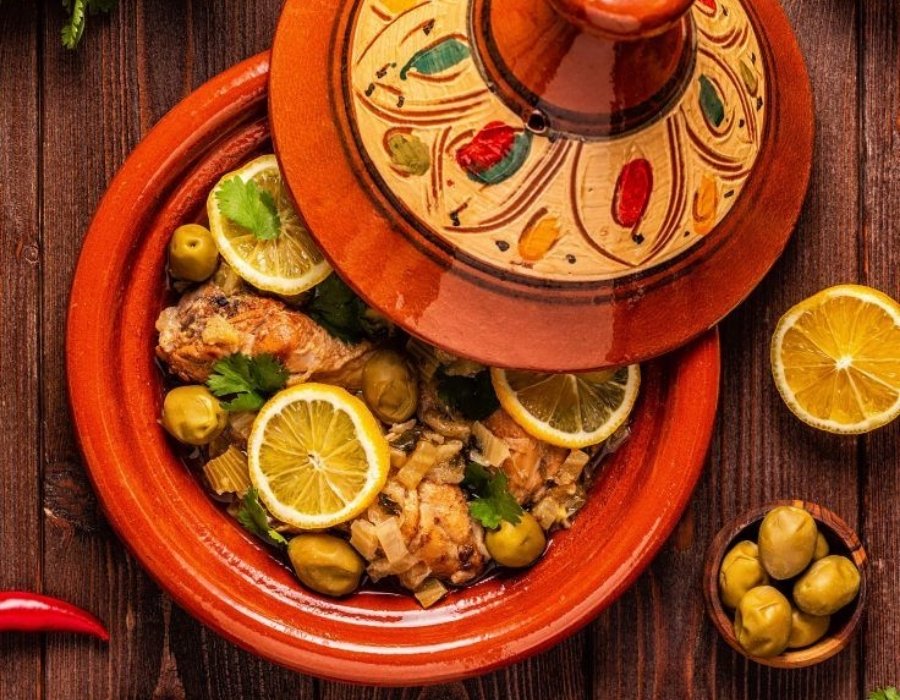
Ingredients:
- 500g lamb or chicken, cut into serving pieces
- 2 medium onions, finely chopped
- 2 cloves garlic, minced
- 2 teaspoons ground cumin
- 2 teaspoons ground ginger
- 1 teaspoon ground cinnamon
- 2 tablespoons olive oil
- 1 cup dried apricots or prunes (choose your preference)
- Salt and freshly ground black pepper to your taste
- A handful of fresh coriander, roughly chopped, for finishing
Instructions:
- In your tagine pot or a sturdy, heavy-based pot, heat the olive oil over medium heat. Add the meat and brown it well on all sides to build flavor.
- Stir in the chopped onions and minced garlic. Cook until they soften and become translucent.
- Add the ground cumin, ginger, cinnamon, salt, and pepper. Stir everything together, ensuring the meat is well coated with the spices.
- Pour in just enough water to partially submerge the meat. Bring it to a gentle boil, then significantly reduce the heat to a very low simmer.
- Nestle the dried apricots or prunes among the meat.
- Cover the tagine or pot tightly and let it cook slowly for 1 to 2 hours, or until the meat is incredibly tender and falls away easily.
- Just before serving hot, scatter fresh coriander over the top. It’s heavenly served with warm Moroccan bread or alongside couscous – a true taste of Moroccan cooking and a pillar of Moroccan cuisine.
2. Couscous: More Than Just a Grain in Moroccan Food
While technically a grain product made from durum wheat semolina, couscous is a foundational element in North African cooking and holds significant cultural weight in Morocco, especially during the cherished “Couscous Friday” tradition. The magic is in how the tiny grains are repeatedly steamed, creating a remarkably light and fluffy base perfectly suited to absorbing the rich flavors of the accompanying stewed vegetables and meats. More than a dish, its communal serving style underscores its role in gathering families and fostering togetherness, making it a vital part of Moroccan cuisine and social life. Experiencing Couscous is essential to understanding Moroccan food culture.
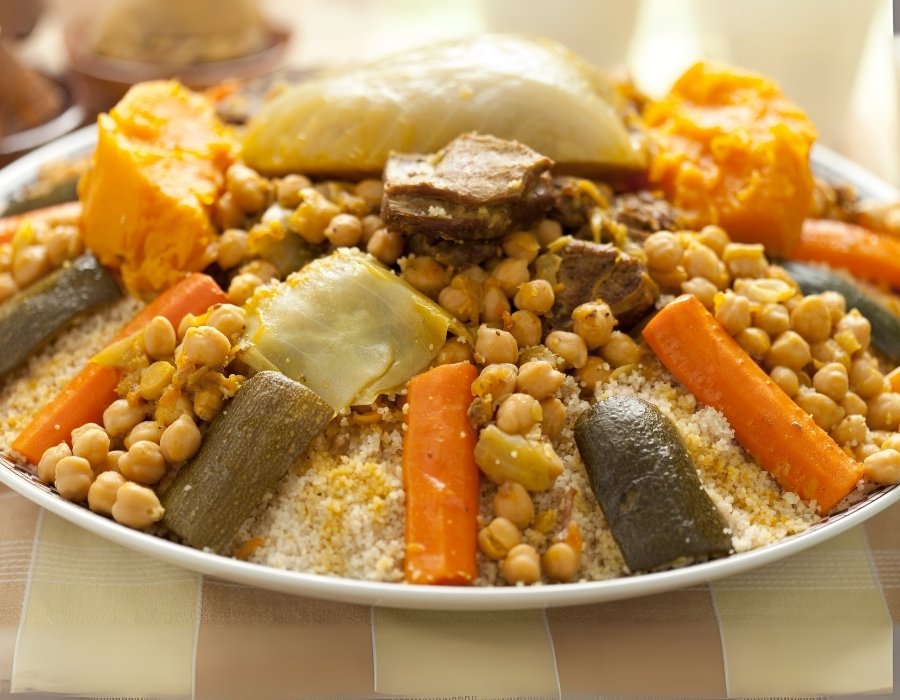
Ingredients:
- 1 cup medium-grain couscous
- 1 cup boiling liquid (water, vegetable broth, or chicken broth all work)
- 1 tablespoon olive oil
- Salt to season
- Assortment of hearty vegetables (such as carrots, zucchini, turnips, pumpkin, chickpeas)
- Meat of your choice (lamb, chicken, or beef), if desired
Instructions:
- Place the dry couscous in a heatproof bowl large enough to hold it once cooked.
- Pour the boiling water or broth over the couscous, add the olive oil and salt, and give it a gentle stir to distribute.
- Cover the bowl snugly with plastic wrap or a lid and let it sit undisturbed for 5 to 10 minutes, or until all the liquid has been absorbed.
- Once the liquid is gone, use a fork to gently fluff and separate the grains. Marvel at how light and airy they are!
- Meanwhile, prepare your chosen vegetable and meat stew in a separate pot – this is the flavorful partner for your couscous.
- To present, mound the fluffy couscous onto a large serving platter, creating a slight well in the center. Spoon the rich vegetable and meat stew generously into the well and around the edges of the couscous. Enjoy this staple of Moroccan cuisine!
3. Harira: The Comforting Fast-Breaker of Moroccan Cuisine
Harira is Morocco’s answer to a soul-warming soup, holding a particularly revered place during the holy month of Ramadan as the traditional dish to break the day’s fast. It’s a deeply satisfying blend built on a base of tomatoes, packed with protein from lentils and chickpeas, and infused with a warm symphony of Moroccan aromatic spices. Often, small pieces of meat are included for extra richness. A final touch of fresh lemon juice before serving cuts through the richness and adds a welcome brightness. More than just sustenance, Harira is a fundamental part of Moroccan religious and communal practice, a symbol of warmth and coming together through Moroccan food. It exemplifies the heartiness of Moroccan cuisine and Moroccan cooking.

Ingredients:
- 1 large onion, finely chopped
- 2 large ripe tomatoes, peeled and diced, or one 400g can crushed tomatoes
- 1 cup brown or green lentils, rinsed thoroughly
- 1/2 cup cooked chickpeas
- 2 stalks celery, chopped
- Small pieces of lamb or beef (optional, for added depth)
- 2 teaspoons ground ginger
- 1 teaspoon ground turmeric
- 1 teaspoon ground cinnamon
- Salt and black pepper to taste
- A generous handful of fresh coriander and parsley, chopped
- Lemon wedges, for serving
- “Tadwira” (a thickening liaison of flour and water or sometimes lentils and flour), optional
Instructions:
- In a large pot, warm a little olive oil over medium heat. Add the chopped onion and sauté until it’s soft and translucent.
- Add the diced or crushed tomatoes, rinsed lentils, chickpeas, chopped celery, and meat (if you’re using it) to the pot.
- Stir in the ground ginger, turmeric, cinnamon, salt, and pepper.
- Pour in enough water to cover all the ingredients generously – about 6 to 8 cups should do it. Bring the pot to a boil, then reduce the heat, cover, and simmer for 45 to 60 minutes, or until the lentils and meat are tender.
- If you’d like that classic thick Harira texture, prepare the “tadwira”: whisk together 2-3 tablespoons of flour with about 1/2 cup of water until completely smooth. Slowly pour this mixture into the simmering soup while stirring continuously to prevent lumps.
- Stir in a generous amount of fresh chopped coriander and parsley during the final minutes of cooking.
- Serve piping hot, garnished with additional fresh herbs and those essential lemon wedges for squeezing over. Experience this vital part of Moroccan cuisine.
4. Pastilla: Layers of History and Flavor in Moroccan Gastronomy
Pastilla, often known as B’stilla, is a truly exquisite example of Morocco’s sophisticated culinary heritage, reflecting deep roots in Andalusian Spain. This savory-sweet pie features delicate, tissue-thin layers of warqa pastry (a Moroccan dough similar to phyllo) wrapped around a rich filling. While traditionally made with spiced shredded pigeon, chicken is now more common, combined with toasted ground almonds. The final flourish is a dusting of powdered sugar and cinnamon. This interplay of sweet and savory, soft filling within a crisp shell, makes Pastilla a dish reserved for celebrations and special moments – once you taste it, you’ll understand why it is treasured in Moroccan cuisine and represents the height of Moroccan gastronomy. It’s a masterpiece of Moroccan cooking.

Ingredients:
- 500g cooked chicken or pigeon meat, shredded
- 1 medium onion, chopped
- 2 tablespoons olive oil
- 1 teaspoon ground ginger
- 1 teaspoon ground cinnamon, plus more for dusting
- 1/2 teaspoon ground turmeric
- A good pinch of saffron threads, steeped in a little hot water
- 4 eggs, lightly beaten
- 1 cup blanched almonds, fried until golden and ground with a touch of sugar and cinnamon
- 10-12 sheets of warqa pastry (or use phyllo dough if warqa is unavailable)
- Melted butter, for brushing the pastry
- Powdered sugar, for dusting the finished pie
Instructions:
- In a wide pan, heat the olive oil and sauté the chopped onion until it’s softened.
- Add the shredded cooked chicken or pigeon, ground ginger, cinnamon, turmeric, the saffron with its soaking liquid, salt, and pepper. Stir and cook for a few minutes to ensure the flavors are well combined.
- Pour in the lightly beaten eggs and stir gently until they are just cooked through and mixed with the chicken. Remove from the heat and let the mixture cool slightly.
- Prepare your warqa or phyllo pastry. Lay out one sheet and brush it lightly with melted butter. Layer another sheet on top, overlapping slightly, and brush with butter again. Repeat with 4-5 sheets to create the base layers.
- Spread half of the chicken and egg filling evenly over the pastry base, leaving a small border around the edges.
- Sprinkle half of the prepared ground almond mixture over the chicken layer.
- Add another 4-5 sheets of buttered warqa pastry on top of the filling.
- Add the remaining chicken mixture, followed by the remaining ground almonds.
- Finish layering with the remaining warqa sheets, brushing each with butter and carefully tucking the edges underneath to seal the pie.
- Brush the top layer generously with melted butter.
- Bake in a preheated oven at 180°C (350°F) for 25 to 30 minutes, or until the pastry is beautifully golden brown and crisp.
- Allow the Pastilla to cool slightly for a few minutes before giving it a generous dusting of powdered sugar and cinnamon. Cut into wedges and serve. It’s a truly special treat!
5. Kefta Mkaouara (Meatball Tagine): A Comforting Moroccan Home Favorite
This dish is pure comfort! Kefta Mkaouara features spiced meatballs gently simmered in a rich, often slightly sweet, tomato sauce. A delightful touch that makes it extra special is poaching eggs directly in the simmering sauce, adding an extra layer of richness to this beloved Moroccan home-style meal. The blend of spices in the meatballs and the depth of the tomato sauce create a robust and deeply satisfying dish, perfect for gathering around and sharing this piece of Moroccan food culture and Moroccan cooking. It’s a readily accessible part of Moroccan cuisine for families everywhere.
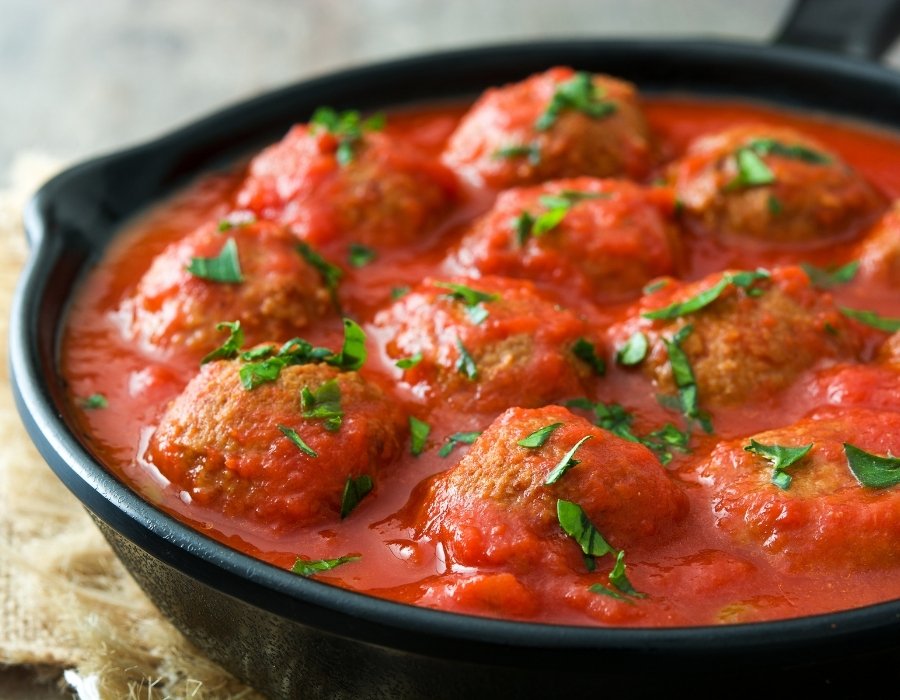
Ingredients:
- 500g ground beef or lamb (or a mix)
- 1 onion, finely chopped (divided in half)
- 2 cloves garlic, minced (divided in half)
- 1 teaspoon ground cumin
- 1 teaspoon ground paprika
- 1/2 teaspoon ground ginger
- 1/4 teaspoon cayenne pepper (optional, for a little warmth)
- Salt and freshly ground black pepper to taste
- 2 tablespoons olive oil
- 1 can (400g) crushed tomatoes
- 1/2 cup water or beef/chicken broth
- 4 large eggs
- Fresh parsley or coriander, chopped, for serving
Instructions:
- In a mixing bowl, combine the ground meat with half of the finely chopped onion, half of the minced garlic, ground cumin, paprika, ginger, cayenne pepper (if using), salt, and pepper. Mix everything together until just combined, taking care not to overmix. Roll the mixture into bite-sized meatballs.
- In a tagine or a large, deep skillet, heat the olive oil over medium heat. Add the remaining chopped onion and minced garlic and sauté until they are softened.
- Pour in the crushed tomatoes and the water or broth. Add a little more salt and pepper to the sauce. Bring the sauce to a gentle simmer.
- Carefully place the meatballs into the simmering tomato sauce. Cover the pot and let them cook for 15 to 20 minutes, or until the meatballs are cooked through.
- Create four small indentations or wells in the sauce between the meatballs. Carefully crack one egg into each well.
- Cover the pan again and continue to cook for another 5 to 10 minutes, or until the egg whites are set and the yolks are cooked to your liking (runny is traditional and delicious!).
- Finish by generously scattering fresh chopped parsley or coriander over the top before serving hot. This dish is fantastic with crusty bread for soaking up the sauce.
6. Zaalouk: Morocco’s Flavorful Eggplant Dip in Moroccan Mezze
Zaalouk is a classic Moroccan cooked salad that often doubles as a delicious dip, highlighting the simple goodness of local produce like eggplant and tomatoes. Typically, eggplants are roasted or fried until smoky and tender, then combined with ripe tomatoes, fragrant garlic, and a blend of key Moroccan spices like cumin and paprika. It’s often lightly mashed to a rustic texture and always finished with a generous drizzle of high-quality olive oil. The combination of smoky, tangy, and garlicky notes makes Zaalouk a popular item in a Moroccan mezze spread or a wonderfully flavorful side dish, showcasing the versatility found within Moroccan cuisine. It’s a refreshing example of Moroccan food.
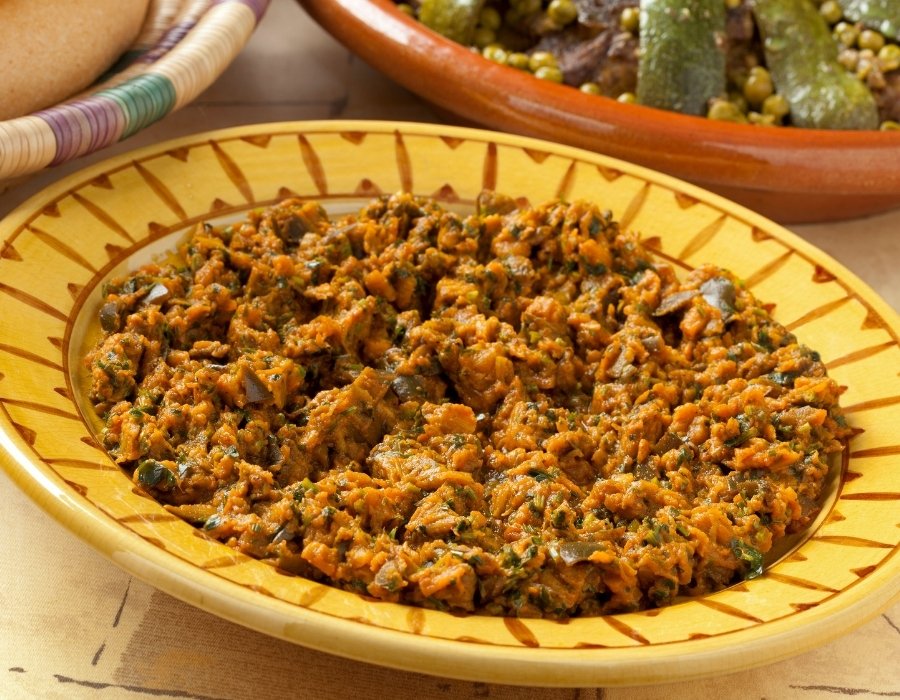
Ingredients:
- 2 medium-sized eggplants
- 3 ripe tomatoes, peeled and diced, or one 400g can crushed tomatoes
- 4-5 cloves garlic, minced
- 3 tablespoons olive oil, plus more for drizzling
- 1 teaspoon ground cumin
- 1 teaspoon ground paprika
- 1/4 teaspoon cayenne pepper (optional)
- Salt and freshly ground black pepper to taste
- 1 tablespoon chopped fresh coriander
- 1 tablespoon chopped fresh parsley
Instructions:
- For that lovely smoky flavor (recommended): Preheat your oven to 200°C (400°F). Pierce the eggplants several times with a fork and place them on a baking sheet. Roast for 45 to 60 minutes, or until their skins are collapsed and the eggplants are very soft inside. Let them cool slightly, then peel off the skin and roughly chop or mash the flesh.
- Alternatively, to fry the eggplants: Peel and cube the eggplants. Heat enough olive oil in a large pan over medium-high heat to fry the eggplant until golden brown and softened. Remove with a slotted spoon and set aside.
- In the same pan (you might need to add a little more olive oil if you fried the eggplant), sauté the minced garlic for about 30 seconds until you can smell its fragrance.
- Add the diced or crushed tomatoes, ground cumin, paprika, cayenne pepper (if using), salt, and pepper to the pan. Cook, stirring occasionally, for 10 to 15 minutes, or until the tomatoes have broken down and the sauce has thickened a bit.
- Stir the roasted or fried eggplant into the tomato mixture. Use a fork or potato masher to mash the mixture to your preferred consistency – some like it quite chunky, others prefer it smoother.
- Stir in the fresh chopped coriander and parsley. Let it cook for another 5 to 10 minutes to allow all the flavors to marry.
- Transfer the Zaalouk to a serving dish. Before serving warm or at room temperature, drizzle generously with good quality olive oil. It’s perfect scooped up with bread!
7. Briouates: The Delightfully Crispy Envelopes, a Moroccan Street Food Gem
Moroccan Briouates are cherished, crispy pastries often filled with savory ingredients like spiced chicken or meat, or sweet fillings like almond paste. These delightful parcels, typically folded into neat triangles, are a staple for celebrations, during Ramadan, and can be found as popular Moroccan street food. Their satisfying crunch and flavorful fillings make them distinct from other pastries, offering a true taste of Moroccan gastronomy. This recipe focuses on a savory chicken filling.
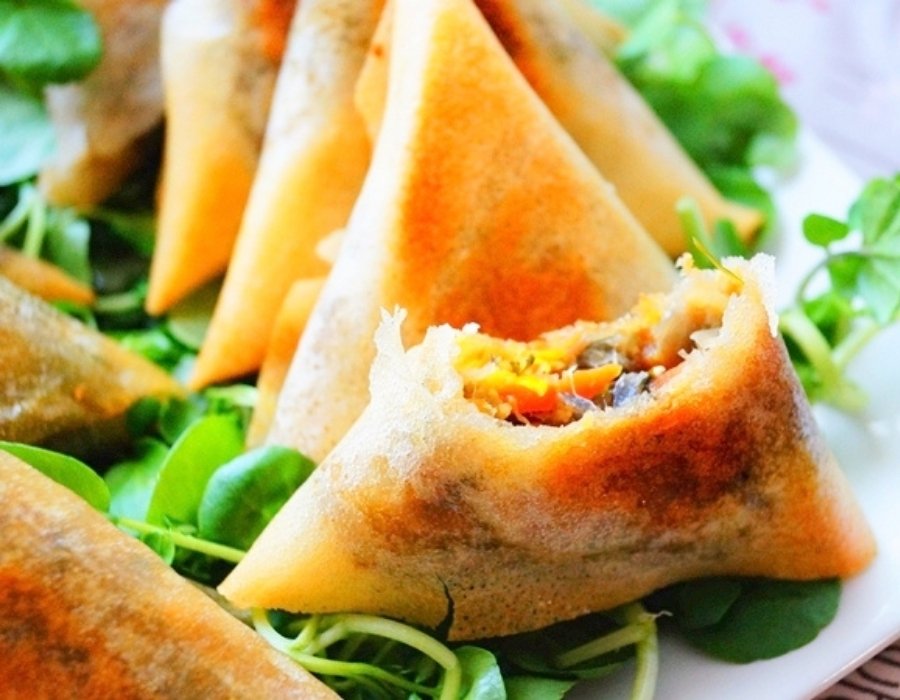
Ingredients:
- 2 cups cooked chicken, finely shredded or minced
- 1 tablespoon olive oil
- 1 small onion, finely chopped
- 2 cloves garlic, minced
- 1/4 cup finely chopped fresh parsley and coriander
- 1/2 teaspoon ground ginger
- 1/4 teaspoon ground turmeric
- 1/4 teaspoon ground cinnamon (optional, but adds depth to savory fillings)
- Pinch of saffron threads (optional), steeped in a little hot water
- Salt and black pepper to taste
- Dash of cayenne pepper (optional)
- Approx. 10-12 sheets of warqa pastry or phyllo dough (if using phyllo, you’ll need more layers)
- Melted butter or a mix of butter and oil for brushing pastry
- Oil for deep frying, or egg wash for baking
- Optional: 1/4 cup vermicelli noodles, soaked and chopped; 1/4 cup chopped olives; 1/4 cup crushed toasted almonds (adds texture)
Instructions:
- Prepare the filling: If starting with uncooked chicken, cook it (boil, steam, or pan-fry) until tender, then shred or mince finely.
- In a skillet, heat the olive oil over medium heat. Add the chopped onion and sauté until softened. Stir in the minced garlic and cook for another minute until fragrant.
- Add the shredded chicken, chopped parsley and coriander, ground ginger, turmeric, cinnamon (if using), saffron with its water (if using), salt, pepper, and cayenne (if using). If using vermicelli, olives, or almonds, stir them in now. Cook for 5-10 minutes, stirring well to combine the flavors. The mixture should be relatively dry; excess moisture will make the pastry soggy. Let the filling cool completely.
- Prepare the pastry: If using warqa, separate the sheets carefully. If using phyllo, keep it covered with a damp towel while you work, and you will likely use 2-3 layers per briouate for strength, layering them on top of each other. Cut the pastry sheets into strips about 3-4 inches wide.
- Fold the briouates: Take one strip of pastry. Brush it lightly with melted butter/oil. Place a tablespoon of the cooled filling at one end of the strip. Fold the corner over the filling to form a triangle. Continue folding the triangle up the strip, like folding a flag, keeping the edges neat and the triangle shape consistent. When you reach the end of the strip, tuck the last flap into the pocket of the triangle to seal it. Brush the outside of the folded triangle lightly with more butter/oil (for frying) or egg wash (for baking).
- Repeat with the remaining filling and pastry strips until you have formed all your briouates.
- Cook the briouates:
- To Fry: Heat about 1-2 inches of oil in a deep skillet or pot over medium-high heat (around 170-180°C / 340-350°F). Carefully add a few briouates at a time. Fry for 2-4 minutes per side, or until golden brown and crispy. Remove with a slotted spoon and drain on paper towels.
- To Bake: Place the brushed briouates on a baking sheet lined with parchment paper. Bake in a preheated oven at 180°C (350°F) for 15-20 minutes, or until golden brown and crispy.
- Serve savory briouates warm as an appetizer or snack. They are a delicious example of Moroccan food versatility.
8. Rfissa: A Nourishing Emblem of Traditional Moroccan Cuisine
Rfissa is a dish that truly speaks of comfort, sustenance, and caring, often prepared for significant moments like welcoming a new baby due to its nourishing qualities. It’s a hearty and incredibly aromatic meal built upon a base of torn pieces of msemen (Moroccan square flatbread) or occasionally meloui (another type of layered flatbread). These are then generously layered with tender chicken and lentils, and everything is bathed in a fragrant, spiced broth infused with saffron, the distinct aroma of fenugreek (if you follow the traditional recipe), and other warming spices. The interplay of textures – the soft, broth-soaked bread with the tender chicken and lentils – makes Rfissa a deeply satisfying and culturally significant dish within traditional Moroccan cuisine and Moroccan food culture. It represents nurturing Moroccan cooking.
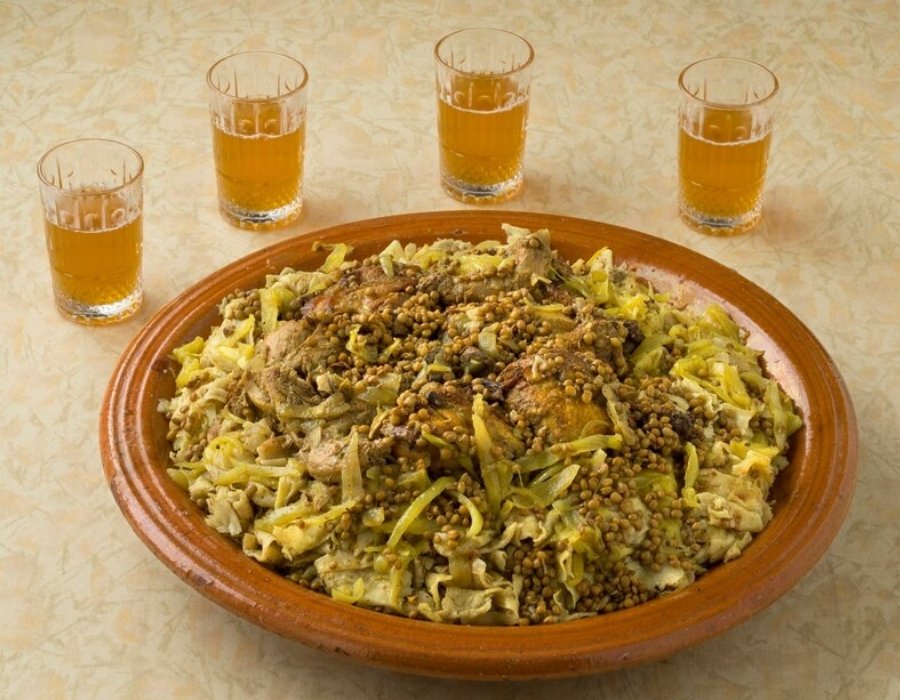
Ingredients:
- 1 whole chicken, cut into pieces
- 2 large onions, chopped
- 4-5 cloves garlic, minced
- 1 cup brown or green lentils, rinsed
- 1 tablespoon ground ginger
- 1 teaspoon ground turmeric
- 1 teaspoon Ras el Hanout (that wonderful Moroccan spice blend!)
- 1/2 teaspoon fenugreek seeds (حلبه – hilba), traditional but optional due to strong aroma
- A good pinch of saffron threads, steeped in a little hot water
- Salt and freshly ground black pepper to taste
- 3-4 tablespoons olive oil
- Enough water to make a generous broth
- 5-6 pieces of pre-made msemen or meloui, torn into bite-sized pieces
Instructions:
- In a large pot or Dutch oven, heat the olive oil over medium heat. Add the chopped onions and sauté until they are soft and translucent.
- Add the chicken pieces to the pot and brown them well on all sides.
- Stir in the minced garlic, ground ginger, turmeric, Ras el Hanout, fenugreek seeds (if using), salt, and pepper. Cook for a few minutes, stirring to coat the chicken thoroughly in the spices.
- Add the rinsed lentils and the saffron with its soaking water to the pot.
- Pour in enough water to generously cover the chicken and lentils. Bring the pot to a boil, then reduce the heat, cover, and let it simmer for 45 to 60 minutes, or until the chicken is cooked through and the lentils are tender.
- While the chicken and lentils are simmering, gently warm the torn pieces of msemen or meloui.
- To serve this communal dish, arrange the warm bread pieces on a large serving platter.
- Generously spoon the chicken, lentils, and plenty of the fragrant broth over the bread, ensuring all the bread pieces are well moistened and soaking up the flavors.
- Serve immediately, inviting everyone to share in this comforting meal.
9. Chebakia: The Festive Honeycomb Treat of Moroccan Food Culture
Chebakia is instantly recognizable by its intricate flower shape and is absolutely essential during the month of Ramadan, though its popularity makes it a welcome sweet treat year-round. These delightful cookies are crafted from a dough flavored with toasted sesame seeds, ground almonds, and aromatic spices like anise and cinnamon. After being deep-fried to a delicate crispness, they are immediately submerged in warm honey syrup, resulting in a unique texture that is both slightly chewy and satisfyingly crunchy, infused with sweet, fragrant honey. Their beautiful, complex shape and association with joyful occasions make them a true symbol of festivity in Moroccan food culture and beloved Moroccan cuisine. Enjoying Chebakia is a sweet part of experiencing Moroccan food.
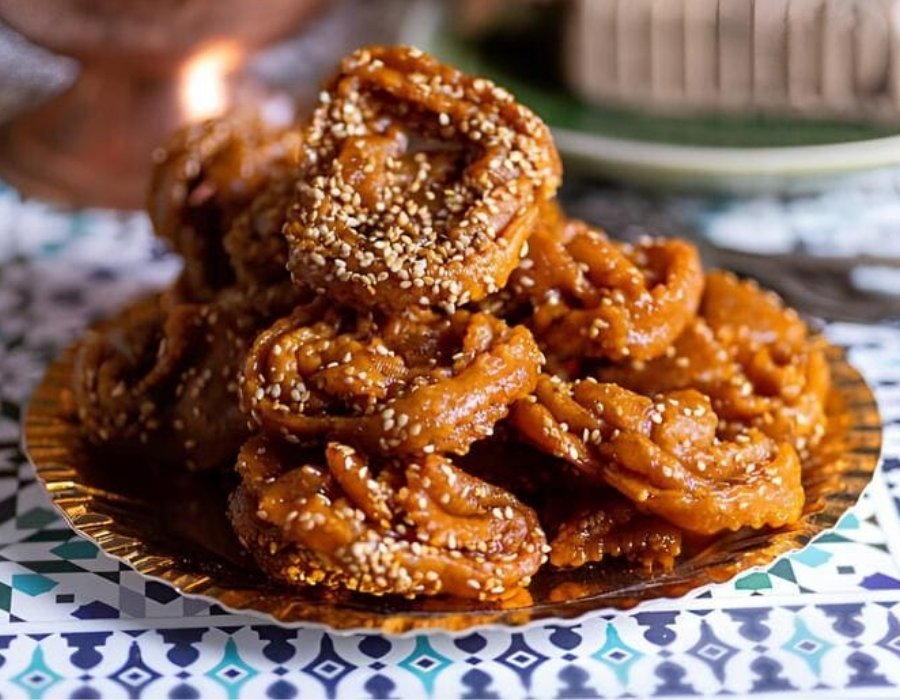
Ingredients:
- 500g all-purpose flour
- 100g toasted sesame seeds, ground finely
- 50g blanched almonds, finely ground
- 1 teaspoon ground anise seeds
- 1 teaspoon ground cinnamon
- 1/4 teaspoon ground mastic gum (optional, but provides a subtle floral note)
- 1/4 teaspoon baking powder
- A pinch of salt
- 1/4 cup melted unsalted butter or traditional smen (aged butter)
- 1/4 cup olive oil
- 1/4 cup orange blossom water
- Approximately 1/2 cup warm water, or as needed to form dough
- Oil for deep frying (vegetable or sunflower oil works well)
- 500g liquid honey, gently warmed
Instructions:
- In a large mixing bowl, whisk together the flour, ground sesame seeds, ground almonds, ground anise, cinnamon, mastic gum (if using), baking powder, and salt.
- Pour the melted butter or smen and the olive oil into the dry ingredients. Use your fingertips to rub the fats into the flour mixture until it resembles coarse breadcrumbs.
- In a separate small bowl, mix the orange blossom water with the warm water. Gradually add this liquid mixture to the flour mixture, mixing as you go until a firm dough begins to form. Turn the dough out onto a lightly floured surface and knead it for a good 10 to 15 minutes until it feels smooth and elastic.
- Divide the dough into several portions and wrap them tightly in plastic wrap. Let the dough rest for at least 30 minutes; this makes it easier to work with.
- Take one portion of dough at a time and roll it out very thinly – you want it to be about 1-2 mm thick. A rolling pin or a pasta machine set on a wide setting works well.
- Using a pastry wheel or knife, cut the rolled dough into rectangles or squares, roughly 8×8 cm (about 3×3 inches).
- Now, shape the Chebakia: Cut 4 parallel slits within each square, leaving a border around the outside so you have 5 strips connected at the edges. Pick up the square, thread one corner through the central slit, and pull gently to create the flower shape. Pinch the edges together to seal. (Don’t worry if this takes practice – online videos are a great resource for this step!).
- Heat the oil for deep frying in a large pot or deep fryer to a medium-high temperature (around 170°C / 340°F).
- Carefully place a few Chebakia into the hot oil at a time. Fry for 2 to 3 minutes per side, or until they turn a beautiful golden brown and look puffed up.
- Using a slotted spoon, lift the fried Chebakia from the oil and immediately drop them into the warm honey bath. Let them soak for at least 10 to 15 minutes, turning occasionally, to soak up all that delicious honey.
- Remove the honey-soaked Chebakia with a slotted spoon, allowing any excess honey to drip back into the pot. Place them on a wire rack set over a tray to catch drips.
- While they are still sticky from the honey, sprinkle them generously with toasted sesame seeds.
- Once cooled, store Chebakia in an airtight container at room temperature. They keep well, though they tend to disappear quickly!
10. Mechoui: The Regal Roasted Lamb, a Feast of Moroccan Cuisine
Mechoui is a truly majestic and celebratory Moroccan dish, centered around a whole lamb (or sometimes a large shoulder or leg) slow-roasted to achieve unparalleled tenderness. Seasoned relatively simply with a blend of spices like cumin and paprika, the lamb is traditionally cooked in a dedicated pit oven or, for home cooks, in a very low oven for many hours until the meat is so tender it literally falls off the bone. The act of eating Mechoui often involves guests pulling off pieces of the incredibly succulent meat by hand, a practice that emphasizes the communal and generous spirit of this feast dish, reserved for significant celebrations and large gatherings within Moroccan cuisine. Experiencing Mechoui is a highlight of Moroccan gastronomy and Moroccan food culture.
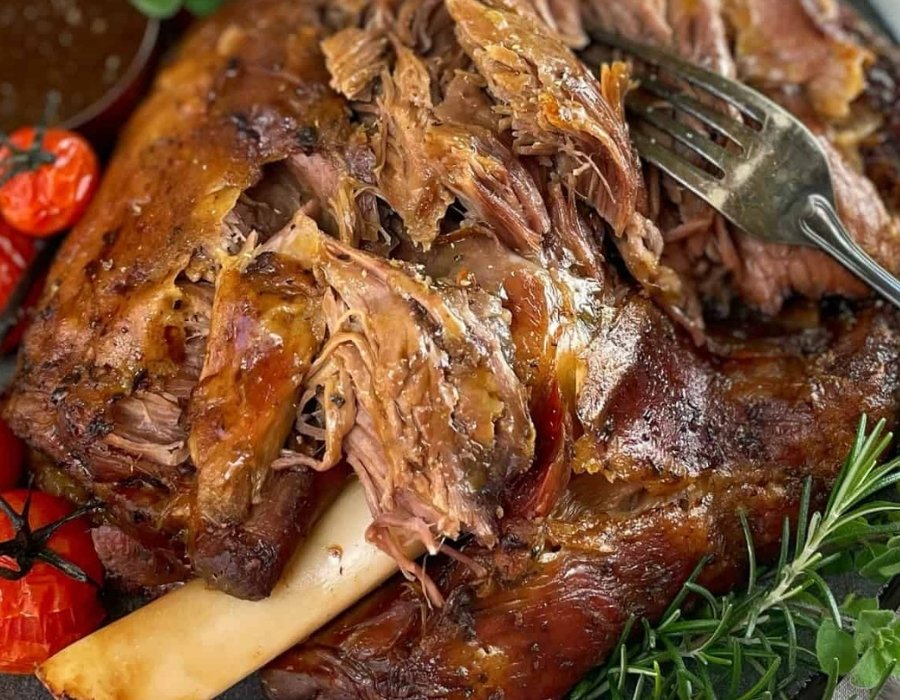
Ingredients:
- 1 whole young lamb, cleaned and prepared (or a substantial lamb shoulder or leg)
- 4-6 tablespoons ground cumin
- 2-3 tablespoons paprika
- 1-2 tablespoons salt (adjust based on the size of the lamb)
- Olive oil
Instructions:
- Ensure your lamb (whole or cut) is properly cleaned and patted dry.
- In a small bowl, mix together the ground cumin, paprika, and salt.
- Rub this spice mixture generously all over the lamb, making sure it’s well-coated everywhere, including any crevices.
- Drizzle the lamb with olive oil and rub it in thoroughly.
- For best flavor, let the seasoned lamb marinate for several hours or ideally overnight in the refrigerator.
- Traditional Method (if you have access to a pit oven): Prepare your pit oven with hot coals. Suspend the seasoned lamb inside the pit and cover it securely. Let it slow-roast in the ambient heat for many hours (a whole lamb can take 6-8 hours or longer) until the meat is unbelievably tender.
- Oven Method: Preheat your oven to a low temperature, around 140°C (275°F). Place the seasoned lamb in a large roasting pan. Cover the pan very tightly with heavy-duty foil.
- Roast the lamb in the low oven for an extended period: 4-6 hours for a shoulder or leg, or 8-12 hours for a whole lamb. The goal is meat that is fork-tender and easily separates from the bone. You can remove the foil for the last hour or so to allow the exterior to crisp up slightly if you like.
- Once cooked, carefully remove the lamb from the oven. Let it rest for 20-30 minutes before serving.
- Serve the Mechoui hot. The traditional way is for people to pull the tender meat directly off the bone by hand and enjoy it with a simple accompaniment of salt and ground cumin for dipping. It’s a truly memorable way to share a meal!
11. Tanjia of Marrakech: The Emblem of Marrakechi Cuisine
Here is a dish deeply tied to one specific city, Marrakech, and it’s named after the unique urn-shaped clay pot it’s cooked in – the tanjia pot itself! The Tanjia is a flavorful, slow-cooked meat dish with a fascinating history. Traditionally, it was prepared by unmarried working men in Marrakech. They would assemble the ingredients in the pot and take it to the local public oven (farnatchi) where it would be buried in the hot ashes and left to cook slowly for hours while they were at their jobs. This method, unique to Marrakech, yields incredibly tender, fall-apart meat infused with the bright, savory notes of preserved lemon, copious garlic, a touch of saffron, and warm cumin. Often playfully called “bachelor’s stew,” the Tanjia of Marrakech is a culinary emblem of the city and an absolute must-experience for anyone seeking authentic Marrakechi cuisine and the soul of Moroccan cooking. It’s a truly iconic Moroccan dish.

Ingredients:
- 1.5 kg lamb or beef (shoulder or shank cuts work best), cut into sizable chunks
- 1 whole preserved lemon, thoroughly rinsed and quartered
- 6-8 cloves garlic, peeled and lightly crushed
- 1 tablespoon ground cumin
- 1 teaspoon ground ginger
- 1 teaspoon paprika
- A pinch of saffron threads, crumbled slightly
- 1/4 cup olive oil
- 1 tablespoon smen (aged butter), adds authentic depth (optional)
- Salt and freshly ground black pepper to taste
- Approximately 1 cup of water
Instructions:
- Place the meat chunks, quartered preserved lemon, crushed garlic cloves, ground cumin, ginger, paprika, crumbled saffron, salt, and pepper into your Tanjia clay pot (or a heavy, deep, oven-safe pot with a secure lid).
- Pour the olive oil over the ingredients and add the smen (if you’re using it).
- Add enough water so it comes up about one-third of the way on the meat.
- Give everything a gentle stir to ensure the meat is coated with the spices and oil.
- Cover the opening of the Tanjia pot very tightly. The traditional method uses parchment paper secured with twine or wire. If using a standard pot, ensure the lid is tight-fitting.
- Traditional Farnatchi Method: Take your prepared Tanjia pot to a local farnatchi in Marrakech and leave it to cook slowly buried in the hot ashes. This slow cooking process takes from 4 to 6 hours, or potentially longer depending on the oven’s heat.
- Oven Method (for cooking at home): Preheat your oven to a low temperature, around 150°C (300°F). Place the covered Tanjia pot in the oven.
- Slow cook for 4 to 6 hours, or until the meat is exceptionally tender and easily falls away from the bone. Check on it periodically; if it seems dry, add a little more hot water.
- Once cooked, carefully remove the Tanjia from the oven. The meat should be wonderfully tender, and the remaining liquid will be a rich, flavorful sauce.
- Serve the Tanjia hot. It’s typically enjoyed directly from the pot or transferred to a serving dish, with pieces of Moroccan bread used to scoop up the tender meat and sauce.
Ultimate Moroccan Street Food: Your Passport to Flavor in Moroccan Cuisine
Beyond the formal dining table lies a vibrant, exciting world – Morocco’s street food scene! It’s where you get a quick, authentic taste of daily life and the country’s culinary heart. From the lively morning markets to the bustling evening squares, the enticing aromas and dynamic energy of Moroccan street food vendors are an unforgettable part of the Moroccan experience. Don’t hesitate to dive in – this is where you’ll find some real, unpretentious deliciousness and another fascinating aspect of Moroccan cuisine. These Moroccan street foods offer quick, flavorful bites and a glimpse into everyday Moroccan food life.
Here are 10 essential Moroccan street foods you absolutely have to seek out and try:
1. Msemen (Moroccan Square Flatbread)
Find these flaky, layered flatbreads sizzling on griddles, especially popular for breakfast. Enjoy them simply with honey or butter, or filled with savory ingredients. Look for the rhythmic sound of the dough being worked! An iconic piece of Moroccan street food.
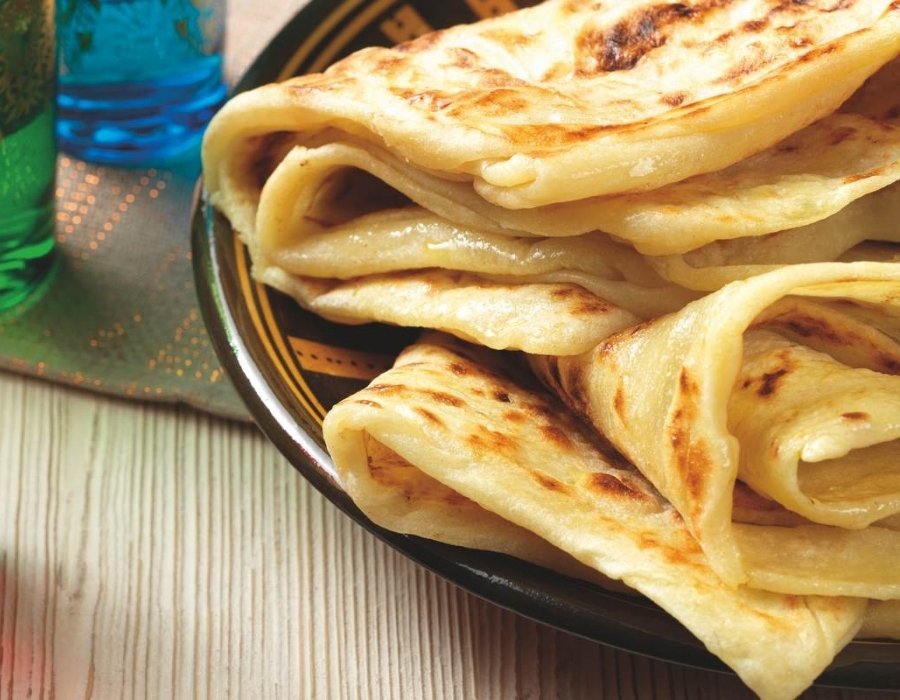
2. Harcha (Griddled Semolina Bread)
This pan-fried semolina bread offers a delightful texture, similar to cornbread, often served warm with a smear of butter and honey. Seek out vendors using traditional ferrah griddles for authenticity. Another staple of Moroccan street food and Moroccan cuisine.

3. Bissara (Creamy Fava Bean Soup)
A wonderfully thick and comforting soup made from dried fava beans, typically served hot and finished with a swirl of olive oil, cumin, and a pinch of paprika. A favorite morning fuel, especially in northern towns. This hearty soup is popular Moroccan street food.

4. Sfenj (Moroccan Fried Rings)
Morocco’s version of a doughnut! These light, airy rings of fried dough are not sweet themselves but are often dipped in sugar or honey. Watching the Sfenj makers shape them is mesmerizing! A classic Moroccan street food treat from Moroccan cuisine.

5. Grilled Sardines (Local Catch)
If you’re by the coast, you absolutely must try the freshly grilled sardines! Marinated in a flavorful chermoula (an herb and spice paste) and cooked over charcoal, they are simple, smoky perfection. Essaouira is particularly famous for these. Delicious Moroccan street food from the sea, showcasing fresh Moroccan food.
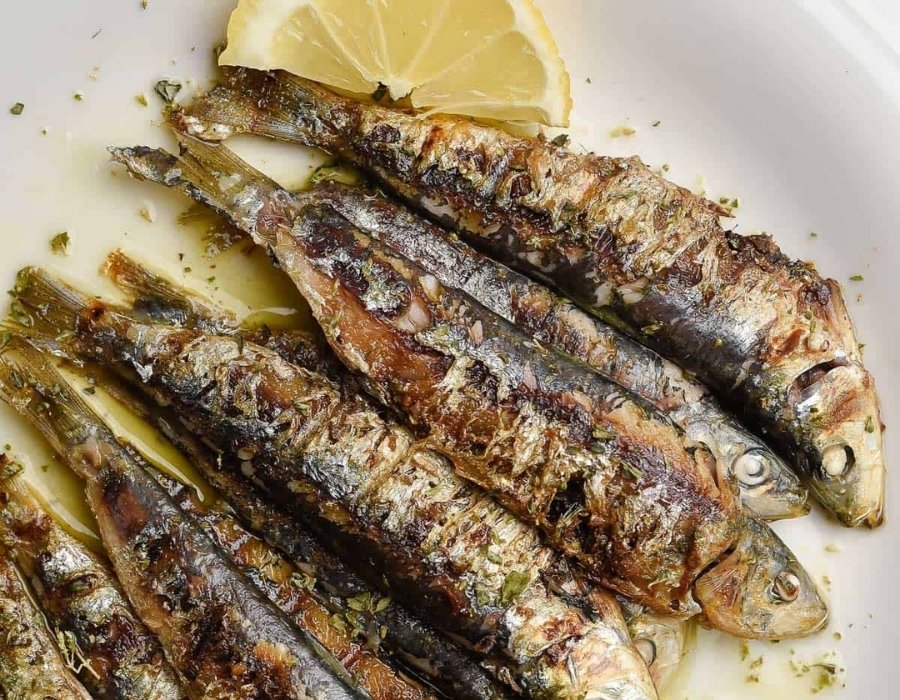
6. Snail Soup (Babbouche Broth)
For the adventurous palate! This unique street food features small snails in an aromatic, complex broth flavored with a blend of numerous spices and herbs. Served hot in small bowls, often with a toothpick for extracting the snails. It’s popular in evening markets like Marrakech’s Jemaa el-Fna and believed to have health benefits. A truly unique Moroccan street food experience within Moroccan cuisine.
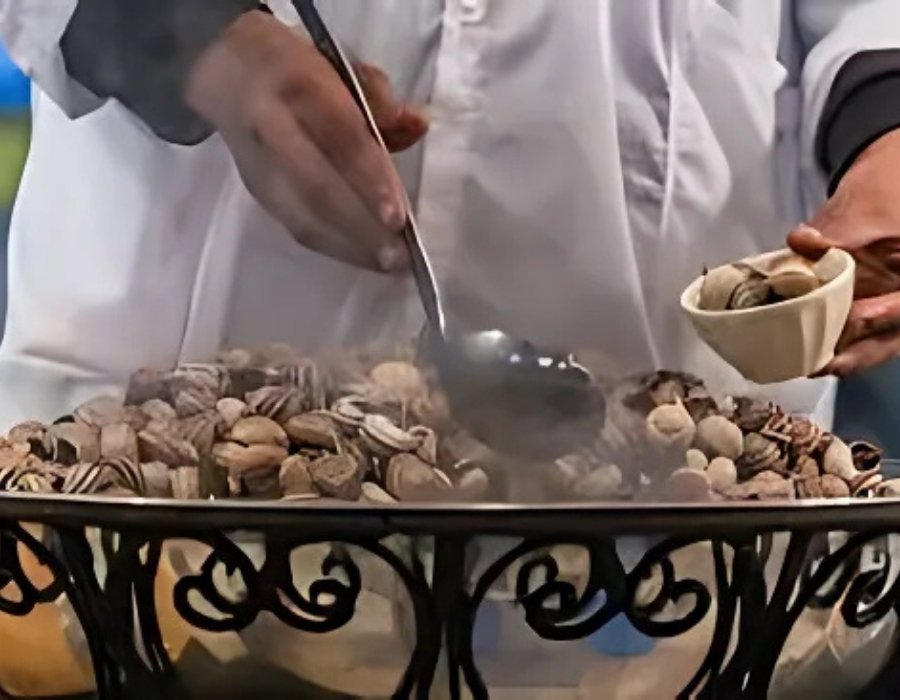
7. Maakouda (Spiced Potato Cakes)
These crispy, fried potato fritters are seasoned with garlic, cumin, and coriander. They make a satisfying snack and are often served with a side of spicy harissa or a garlic-lemon sauce. A popular savory Moroccan street food.

8. Individual Pastilla Portions
While the large pie is for feasts, keep an eye out for smaller, individual servings of the famous savory-sweet Pastilla available from street vendors – a perfect way to get a taste on the go! A delightful Moroccan street food pastry.

9. Brochettes (Grilled Skewers)
The inviting smell of seasoned lamb, beef, or chicken brochettes grilling over hot coals is a signature scent of Moroccan street food markets, especially lively in the evenings. Tender, smoky meat on a stick, usually served with bread. A popular Moroccan street food protein fix within Moroccan cuisine.
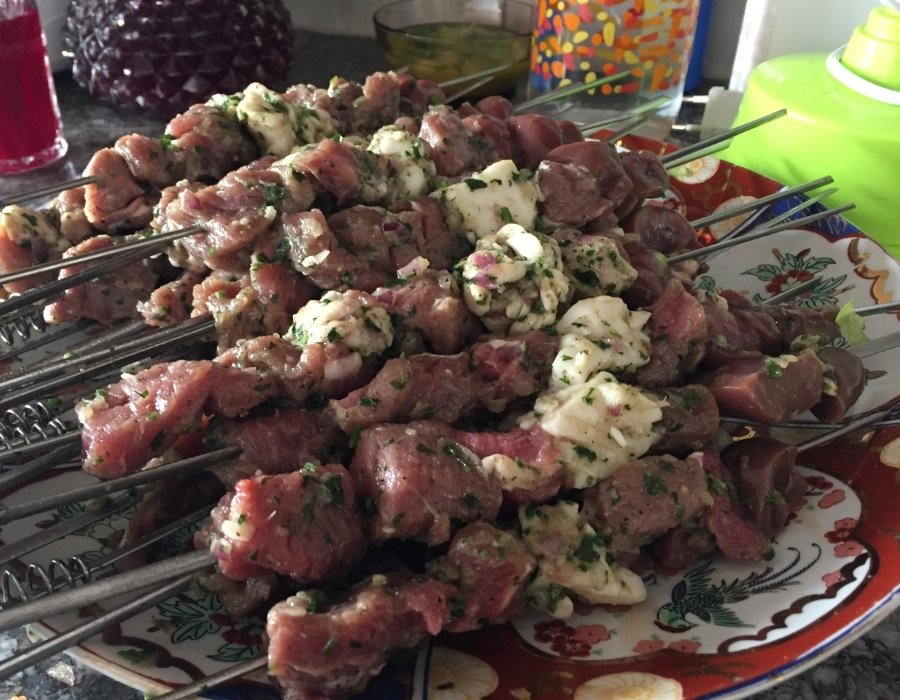
10. Steamed Sheep’s Head
For those seeking a truly authentic and perhaps adventurous culinary experience in Morocco, look no further than Steamed Sheep’s Head. While whole roasted lamb (Mechoui) is renowned, the sheep’s head itself holds a specific, cherished place, often prepared simply to highlight the rich, tender meat found within. It is a traditional, adventurous Moroccan street food, famously found in markets like Marrakech’s Jemaa el-Fna. Prepared by slow-steaming until incredibly tender, the succulent meat is simply pulled off the bone by hand and seasoned with just cumin and salt. It offers a direct, unforgettable taste of Moroccan cuisine for the curious palate, highlighting simple preparation in Moroccan food culture.
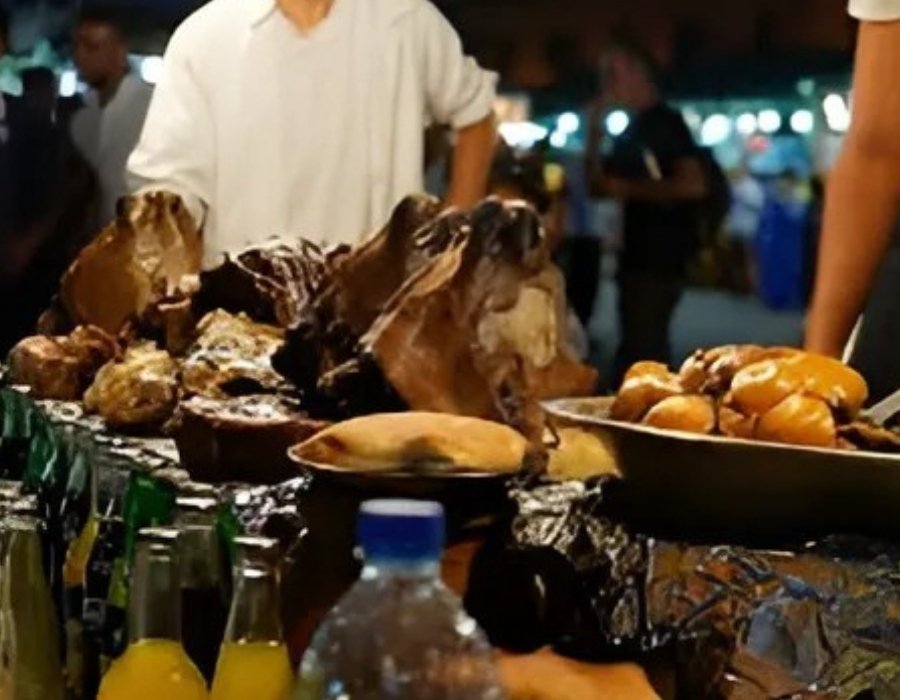
Savor Morocco’s Flavors: Your Culinary Discovery Awaits in Moroccan Cuisine!
What an incredible culinary landscape we’ve explored! From the deeply historic and flavorful Tanjia of Marrakech, born from a unique tradition, to the diverse and exciting array of Moroccan street foods like the intriguing Babbouche found in bustling squares, Moroccan cuisine offers a truly unforgettable experience for your taste buds. Each dish is more than just ingredients; it’s a reflection of history, deeply held traditions, and the incredible warmth of Moroccan hospitality. Exploring traditional Moroccan dishes and Moroccan street food reveals the heart of the culture and the depth of Moroccan gastronomy. The variety found in Moroccan food is simply astounding.
Are you feeling inspired to try your hand at cooking some of these authentic Moroccan dishes or perhaps plan a trip to experience them firsthand and immerse yourself in Moroccan cuisine?
We warmly invite you to Visit MorocConnect! Our platform is your gateway to discovering more about Moroccan culture, planning your travels, and gaining deeper insights into this captivating country and its incredible Moroccan food scene.
And, for those moments when you’re ready to bring the genuine tastes of Moroccan cooking into your own kitchen, make sure to shop at the MorocConnect Marketplace! We connect you with authentic ingredients to help you recreate these wonderful flavors of Moroccan cuisine, delivered right to your door.
Start your exploration, get cooking, and allow yourself to fully savor the magic and rich flavors of Moroccan cuisine!

